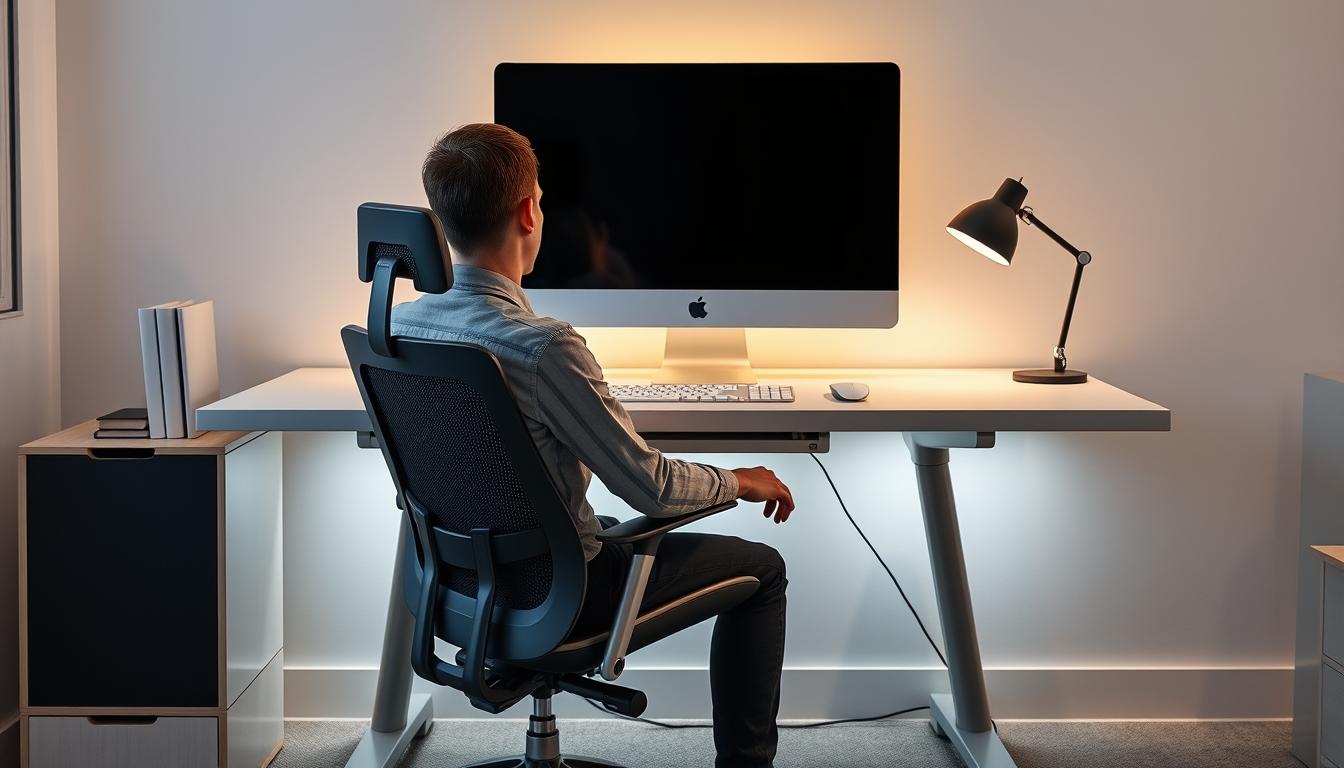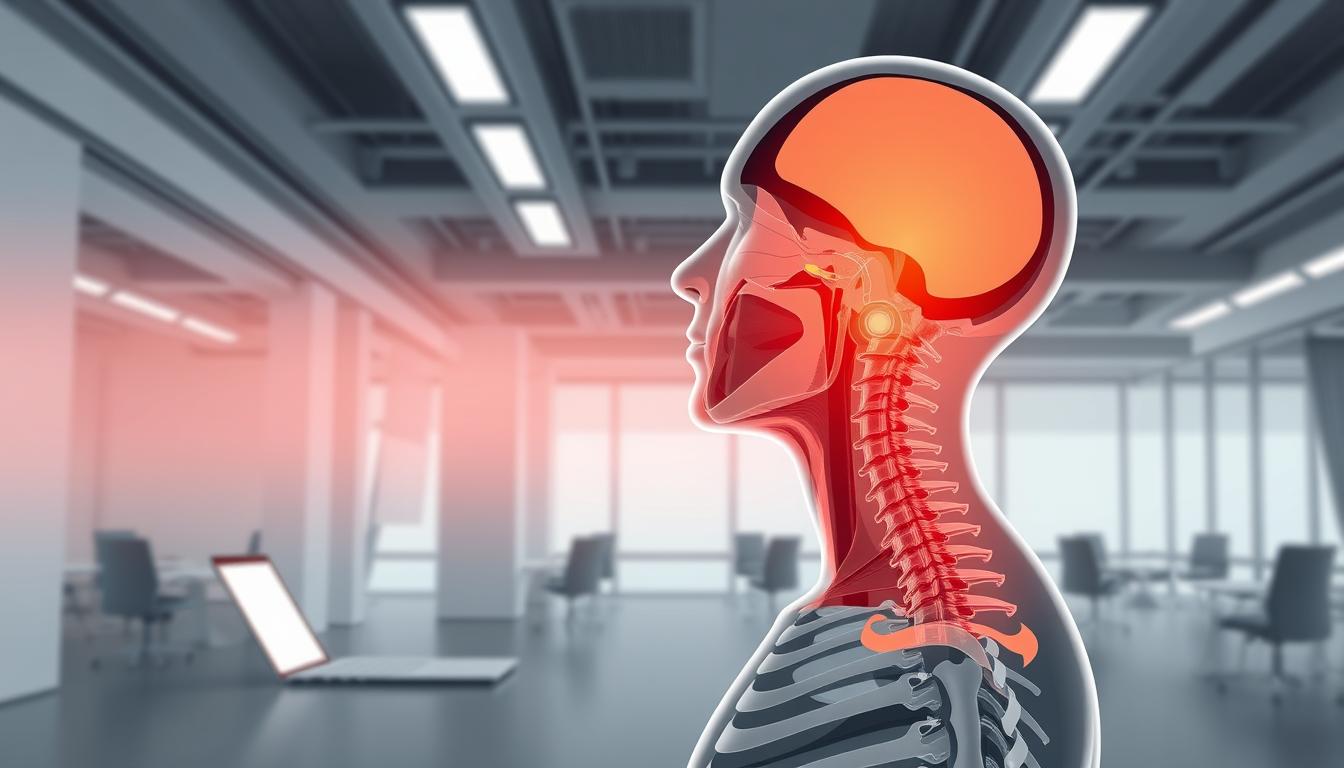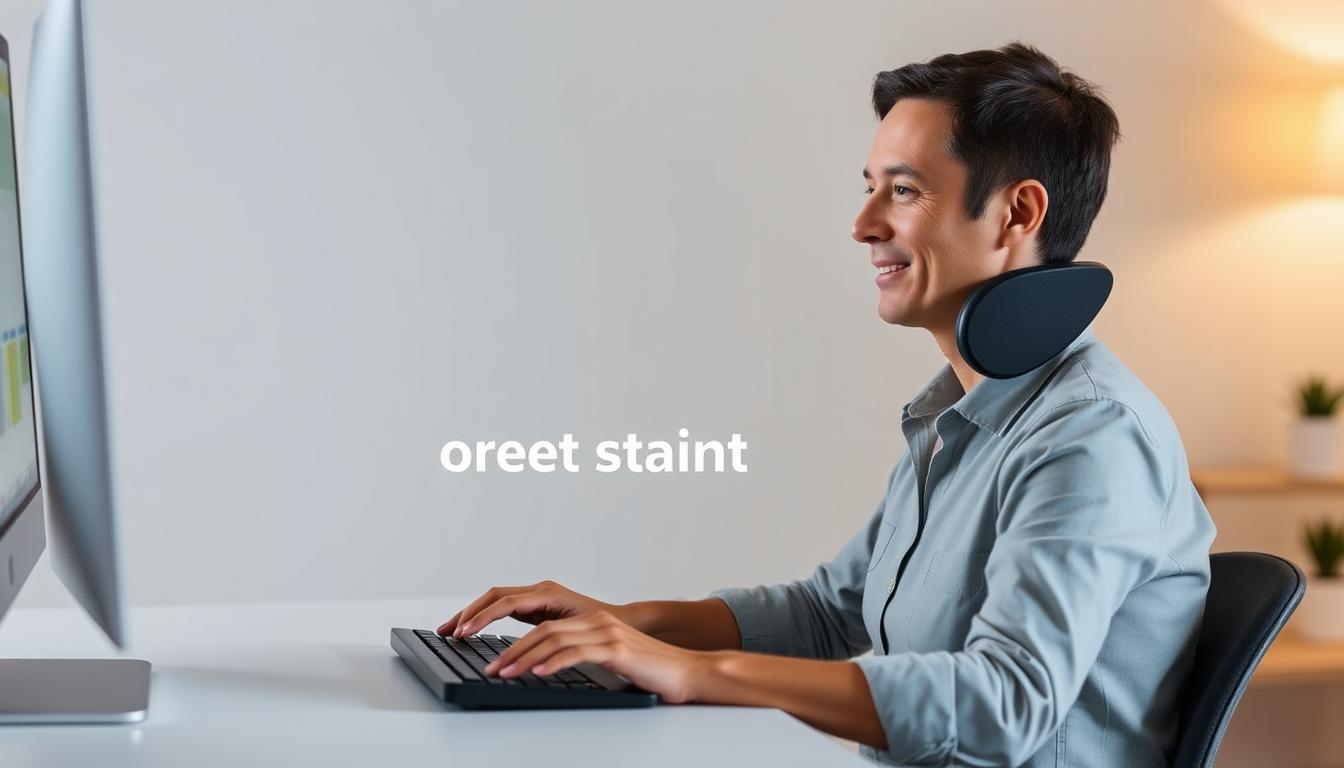Today, preventing neck pain is more important than ever, especially with many of us working from home. It’s vital to grasp how ergonomic tips can boost workplace comfort and productivity. Ergonomics focuses on setting up work areas to improve comfort and work efficiency.
Many people working from home often suffer from neck pain due to poor desk setups. To address this, we’ll look into top strategies for designing an ergonomic workspace. These tips will help make sure your desk setups promote health and productivity.
Understanding the Importance of Ergonomics
Ergonomics in the workplace is more than just comfort. It’s crucial for creating a work area that reduces discomfort and boosts efficiency. A well-set-up workspace lowers the chances of getting neck and back pain. This pain can really slow down how much work gets done.
Studies show making the right changes to how your chair, desk, and tools are set up brings big ergonomic wins. These changes help workers stay comfy during long hours without hurting their bodies. Being comfortable at work is key. It makes the atmosphere better and helps people do their best.
Common Causes of Neck Pain in the Workplace
Understanding what causes neck pain helps prevent discomfort at work. Many factors lead to neck strain, including poor posture. Most people don’t know how they sit or stand during work. Sitting too long without breaks can also make neck pain more likely.
Neck pain at work can come from bad workstation setups. The right chair can make a huge difference in keeping your spine happy. If your desk is too high or low, it can force your neck into bad positions. This can make neck tension worse.
Office jobs often mean sitting down a lot, which isn’t good for your neck. Looking down at phones and computers too much can cause tech neck. Knowing about these problems means we can fix them with the right office setup and taking breaks to move around. This helps make workplaces more comfortable.
Neck Pain Prevention Through Desk Ergonomics
Using the right desk ergonomics is key to avoiding neck pain at work. It’s vital to choose a chair that provides strong support. Also, adjusting the height of your desk properly matters a lot.
Proper Chair Selection for Neck Support
Choosing the correct chair can make a big difference in your comfort. This can help lessen neck strain. You should look for certain features in a chair, such as:
- Lumbar support that keeps your lower back naturally curved
- Adjustable armrests to keep your shoulders relaxed
- A height that lets your feet stay flat on the floor
These features work together to improve your sitting posture. They also help reduce neck pain during long work hours.
Optimal Desk Height Adjustments
Setting your desk at the right height is also essential. Your desk must allow your forearms to stay parallel to the floor while you type. This position is crucial because it:
- Lessens strain on your neck and shoulders
- Promotes a balanced way of sitting
- Helps avoid tension after sitting for a long time
By applying these ergonomic methods, you’ll make your workspace healthier. This supports your well-being overall.
Monitor Positioning for Reducing Strain
Setting up your monitor correctly is key to avoiding neck strain and staying comfortable. By arranging your screens ergonomically, you can lower the chance of neck pain. It’s important to pay attention to how high and how far your screens are, especially if you use more than one.
Ideal Monitor Height and Distance
Your monitor should be at or just below eye level. This helps keep your head in a natural position and eases neck strain. The right distance is between 20 to 40 inches from your eyes. This makes sure you can see well without having to lean in or stretch out.
Using External Monitors Effectively
Adding external monitors is especially good for people who use laptops. They let you adjust the screen’s position for better comfort. Changing the brightness and font size also helps ease eye and neck strain. Regular checks to make sure everything is set up right can keep you comfortable and efficient at work.
Keyboard and Mouse Placement Tips
Setting up your keyboard and mouse the right way is key to less strain. It makes long work periods more comfortable. Having them aligned right improves work and wellness. It’s vital to keep your keyboard and mouse in the best spots to avoid wrist issues and injuries.
Ergonomic Keyboard and Mouse Setup
Put the keyboard straight in front of you for the best wrist position. This helps keep wrists happy and arms in line with the floor. The keyboard’s height should let your elbows bend comfortably, about 90 degrees. Keep the mouse close to the keyboard to lessen shoulder stress and reaching too much.
Maintaining Proper Wrist Alignment
Think about getting a wrist rest for better wrist position. It supports a neutral wrist position, which is important when typing or mouse-using. Don’t tilt your wrists too much; it could lead to pain. Taking breaks and stretching out can ease wrist and forearm stress for a comfy setup.
Incorporating Movement and Breaks into Your Routine
It’s really important to move around if you sit a lot at work. This keeps your neck from getting stiff and sore. To stay healthy and clear-headed, try to take short breaks often to move or stretch.
Establishing a Schedule for Breaks
Having a set time for breaks helps keep your neck from tensing up. Try to take a quick break every 30 minutes. Even a short stretch or walk helps your muscles relax. Here are some tips to remember:
- Use a timer or reminder app on your phone or computer.
- Incorporate breaks into daily meetings or tasks.
- Engage with colleagues during breaks to promote a healthy workplace culture.
Stretching Exercises for Neck Relief
Doing simple stretches can ease neck tension and pain. Adding these stretches when you take a break is a smart move. Here are some easy ones you might try:
- Neck Tilts: Gently tilt your head towards one shoulder and hold for 15-30 seconds. Repeat on the other side.
- Shoulder Shrugs: Lift both shoulders towards your ears, hold for a moment, then relax them down. Repeat several times.
- Chin Tucks: Sit up straight and gently tuck your chin towards your chest, holding for a few seconds before releasing.
Taking regular breaks for movement and doing these stretches are great ways to avoid neck pain. They can make you feel better while you work.

Utilizing Technology for Neck Pain Management
In our modern work lives, technology in ergonomics is key to solving neck pain. Standing desks and posture apps are two main helpers in keeping a good posture. They help a lot in feeling better and easing neck pain.
Standing Desks and Their Benefits
Standing desks are now a popular choice to combat neck pain. They help by:
- Helping us stand straight and avoid slouching.
- Cutting down neck pressure by reducing the need to bend over our desks.
- Making us move more, which helps blood flow and lessens stiffness.
A standing desk makes our work area more active. This supports neck health.
Apps for Posture Reminders
Using posture apps is another smart move. These apps remind us to keep our backs straight. They offer:
- Alerts to change our posture or take short breaks.
- Tools to watch how our posture gets better.
- Reminders we can customize to fit our work schedule.
With posture apps, we can take charge of our ergonomic habits. This lessens neck pain and makes working more comfortable.
The Role of Core Strength in Neck Pain Prevention
Core strength is key for keeping your neck healthy. A strong core keeps the body stable and helps with good posture. By having strong core muscles, you avoid too much strain on your neck during everyday tasks.
Doing exercises to make your core stable is not just good for performing better in physical activities. It also lowers the chances of neck pain.
Exercises to Strengthen Core Muscles
For better neck health and stability, try these core-strengthening exercises:
- Planks: Hold a plank position to engage your core while keeping your neck aligned.
- Bridges: Lying on your back, lift your hips while engaging your abdominal muscles.
- Bicycle Crunches: Perform controlled crunches that target both the abs and obliques.
- Dead Bugs: Lying on your back, alternate extending opposite limbs while stabilizing your core.
How Core Stability Supports Neck Health
Strong core muscles mean better posture and balance in daily life. When we focus on building core strength, the stress on neck muscles goes down. This helps keep the neck healthy.
Regular core exercise takes away neck tension by improving how we move. Taking steps to strengthen the core not only stops pain. It also boosts our overall health.
Choosing the Right Pillow for Neck Support
Finding the right pillow is key to good neck support while you sleep. The type of pillow you need differs based on how you sleep. It’s important to pick carefully to both sleep well and keep your neck healthy.
Types of Pillows for Different Sleep Positions
Different pillows work best for different sleeping positions. Here are some options:
- Memory Foam Pillows: These pillows adjust to your neck’s shape. They work well for people who sleep on their back or side.
- Latex Pillows: These are tough and supportive, great for back sleepers needing firm neck support.
- Adjustable Pillows: You can change the filling in these pillows. They’re good for any sleeping position and keep your neck straight.
How Pillow Height Affects Neck Alignment
The height of your pillow is key for keeping your neck in line while sleeping. Here are some tips depending on how you sleep:
- Back Sleepers: A pillow of medium height is best. It should support the natural curve of your neck.
- Side Sleepers: A taller pillow works here. It should fill the gap between your shoulder and head for proper support.
- Stomach Sleepers: A slim pillow is ideal. It helps keep your spine straight, avoiding neck strain.
It’s smart to get new pillows every 1 to 2 years. This ensures they keep supporting your neck all night.
Mindfulness and Stress Management Techniques
Dealing with neck pain means looking at both the body and mind. Mindfulness helps soothe the pain by keeping you calm and focused. Adding stress management into daily life improves health, making it easier to deal with pain. These methods shift focus from pain and help the body heal.
Practicing Mindfulness to Alleviate Pain
Mindfulness can really help lessen pain by making you more aware and accepting of now. One way to practice is by visualizing a calm place, which helps relax your mind. This takes your mind off the pain and towards peace. Doing mindfulness often makes you better at handling the stress that can make neck pain worse.
Breathing Techniques for Stress Reduction
Special breathing methods can lower stress. Diaphragmatic breathing, which is taking deep breaths from your belly, triggers a relaxing effect on your body. Making this a regular habit reduces stress and eases neck stiffness. These exercises can lead to less pain and improve your life quality.
Conclusion
Integrating ergonomic tips into your daily life is key to preventing neck pain. This includes choosing the right office furniture and placing monitors correctly. These steps make sure your workspace supports a good posture. This not only eases discomfort but can also boost your productivity and make your job more satisfying.
It’s also important to move regularly and take breaks. Using stress management methods helps reduce neck strain too. Knowing about ergonomics and being aware of your work area greatly improves your comfort and efficiency.
Making ergonomics a priority is investing in your health for a better work life. By applying these tips, keep learning and adapting. This approach helps you stay healthy at work and avoid pain during your career.



